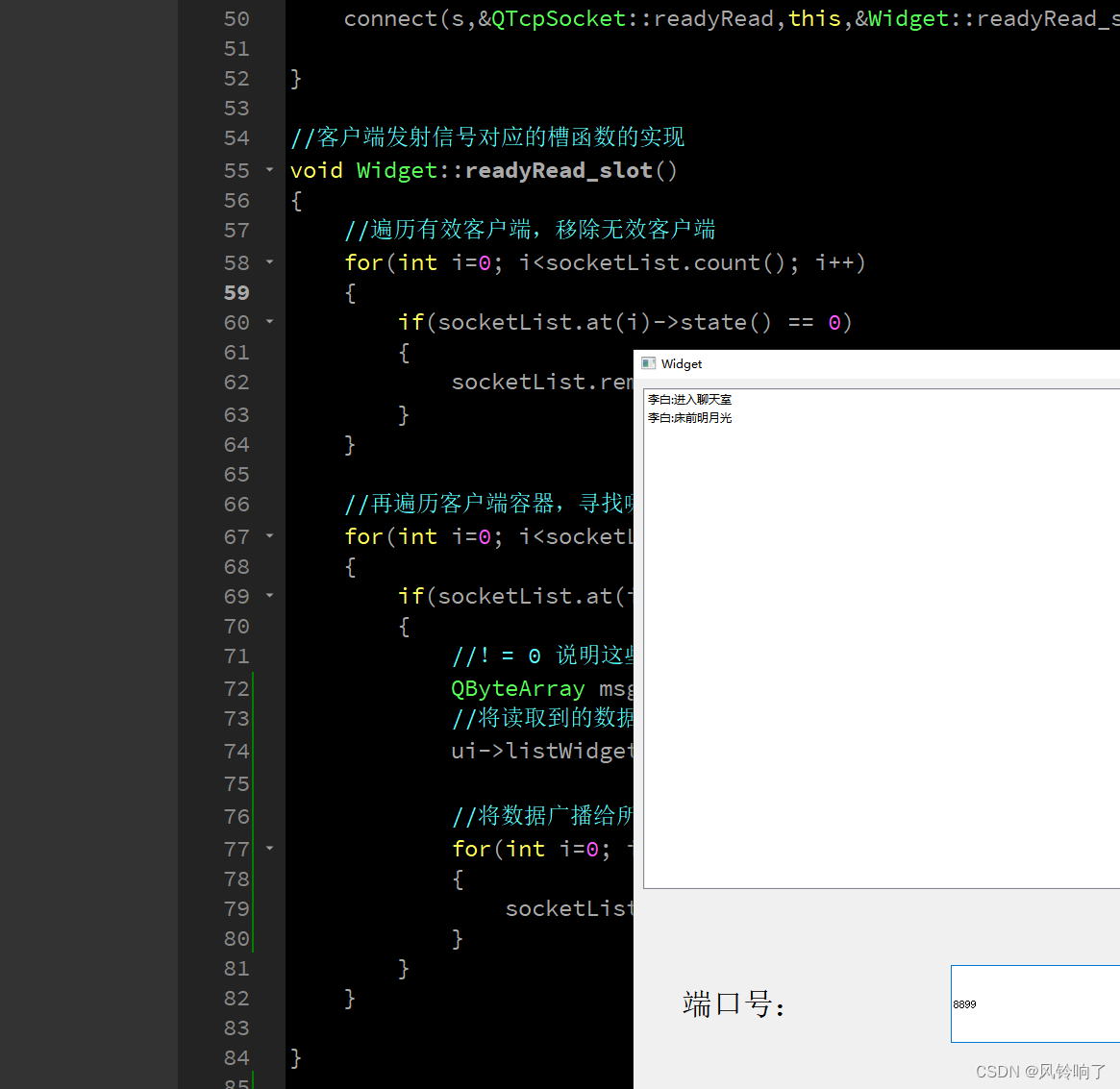Qt 中实现TCP 聊天服务器
大致流程
创建套接字服务器QTcpServer对象
通过QTcpServer对象设置监听,即QTcpServer::listen()
基于QTcpServer::newConnection()信号检测是否有新的客户端连接
如果有新的客户端连接 调用QTcpSocket *QTcpServer::nextPendingConnection()得到通信的套接字对象
使用通信的套接字对象QTcpSocket和客户端进行通信
.pro文件
QT += core gui network # 所需模块network 添加后记得构建greaterThan(QT_MAJOR_VERSION, 4): QT += widgetsCONFIG += c++11# The following define makes your compiler emit warnings if you use
# any Qt feature that has been marked deprecated (the exact warnings
# depend on your compiler). Please consult the documentation of the
# deprecated API in order to know how to port your code away from it.
DEFINES += QT_DEPRECATED_WARNINGS# You can also make your code fail to compile if it uses deprecated APIs.
# In order to do so, uncomment the following line.
# You can also select to disable deprecated APIs only up to a certain version of Qt.
#DEFINES += QT_DISABLE_DEPRECATED_BEFORE=0x060000 # disables all the APIs deprecated before Qt 6.0.0SOURCES += \main.cpp \widget.cppHEADERS += \widget.hFORMS += \widget.ui# Default rules for deployment.
qnx: target.path = /tmp/$${TARGET}/bin
else: unix:!android: target.path = /opt/$${TARGET}/bin
!isEmpty(target.path): INSTALLS += target
.h文件
#ifndef WIDGET_H
#define WIDGET_H#include <QWidget>
#include <QTcpServer> //??包含TCP服务器类
#include <QMessageBox> //消息对话框类
#include <QTcpSocket> //包含客户端类QT_BEGIN_NAMESPACE
namespace Ui { class Widget; }
QT_END_NAMESPACEclass Widget : public QWidget
{Q_OBJECTpublic:Widget(QWidget *parent = nullptr);~Widget();private slots:void on_startBtn_clicked();void newConnection_slot(); //声明一下服务器检测到新的客户端连接时,发射出来的信号到这个槽函数void readyRead_slot(); //声明一下客户端发射的readyRead()信号对应的槽函数private:Ui::Widget *ui;QTcpServer *server; //创建一个套接字服务器QTcpServer对象 在构造函数初始化列表中初始化QList<QTcpSocket *> socketList; //定义一个存放客户套接字的容器
};
#endif // WIDGET_H
main.cpp
#include "widget.h"#include <QApplication>int main(int argc, char *argv[])
{QApplication a(argc, argv);Widget w;w.show();return a.exec();
}
.cpp文件
#include "widget.h"
#include "ui_widget.h"Widget::Widget(QWidget *parent): QWidget(parent), ui(new Ui::Widget),server(new QTcpServer(this)) //初始化列表 初始化server
{ui->setupUi(this);}Widget::~Widget()
{delete ui;
}void Widget::on_startBtn_clicked()
{//定义一个 quint16 类型的变量port 接收 字符串端口转换成 整型的端口quint16 port = ui->portEdit->text().toUInt();//调用 QTcpServer类型的对象server里的listen函数,实现监听if(server->listen(QHostAddress::Any,port)){//启动监听成功QMessageBox::information(this,"","启动服务器成功");}else{//启动监听失败QMessageBox::critical(this,"","启动服务器失败");}//此时服务器已经成功启动监听,如果有客户端发来连接,那么服务器端就会自动发射一个newConnection()的信号//将该信号连接到自定义的槽函数中connect(server,&QTcpServer::newConnection,this,&Widget::newConnection_slot);}//newConnection_slot()槽函数的实现
//有客户端连接时,服务器发射一个newConnection信号后,执行这个函数
void Widget::newConnection_slot()
{//使用QTcpSocket *QTcpServer::nextPenddingConnection()函数得到通信的套接字对象QTcpSocket *s = server->nextPendingConnection();socketList.push_back(s); // 用尾插法将套接字放入链表//如果有客户端发来数据,客户端就会自动发射一个readyRead信号,就可以将该信号连接到自定义的槽函数中connect(s,&QTcpSocket::readyRead,this,&Widget::readyRead_slot);}//客户端发射信号对应的槽函数的实现
void Widget::readyRead_slot()
{//遍历有效客户端,移除无效客户端for(int i=0; i<socketList.count(); i++){if(socketList.at(i)->state() == 0){socketList.removeAt(i); //删除该元素}}//再遍历客户端容器,寻找哪个客户端的数据待读for(int i=0; i<socketList.count(); i++){if(socketList.at(i)->bytesAvailable() != 0){//!= 0 说明这些是有效数据QByteArray msg = socketList.at(i)->readAll();//将读取到的数据 放到ui界面上ui->listWidget->addItem(QString::fromLocal8Bit(msg)); //fromlocal8bit() 将Windows的GBK字符转换为Qt的Unicode//QString::Local8bit是本地操作系统设置的字符集编码//将数据广播给所有客户端for(int i=0; i<socketList.count(); i++){socketList.at(i)->write(msg);}}}}






)

)










